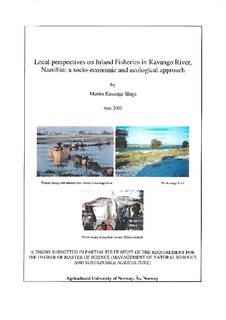| dc.contributor.author | Shapi, Martin Kasanga | |
| dc.date.accessioned | 2015-11-11T14:12:14Z | |
| dc.date.available | 2015-11-11T14:12:14Z | |
| dc.date.copyright | 2002 | |
| dc.date.issued | 2002-01-01 | |
| dc.identifier.uri | http://hdl.handle.net/11250/2360106 | |
| dc.description.abstract | From ancient time fisheries has been a major source of food for humanity and provider of employment and economic benefits to those engaged in it. Namibia is an arid country and with limited freshwater fisheries, chiefly found in the northern part of the country (Kavango and Zambezi River in the Caprivi region).Although freshwater fisheries is limited in Namibia, it serves a vital societal role in terms of food security and source of income. This stydy attempts to describe the status of Kavango fisheries from local people's and ecological perspectives. The study further attempts to analyse historical development of fisheries in Kavango and relate it to questions of sustainable resource utilisation in terms of ecosystem dynamic, socio-economic processes, institutions and rules and regulations. This was done by looking at the rationale behind the use of different types of gear (traditional and modern), socio-economic characteristics of fishing population, people's perception about the carrying capacity of fish resource and most efficient way of managing the resource (i.e. traditional, government or both). The results of this study indicated that some fish species have declined, and there is a growing awareness among local people that modern gears are the cause. People in Kavango seemed to prefer traditional over modern gears. There seemed to be few formal employment opportunities in the area, and the sale of fish as source of income has increased and to continue to increase further in the future. Both traditional and government laws and regulation are poorly enforced. However, the local people preferred fishing to be traditionally regulated. As is often the case in rural communities in Africa, women have the main household responsibility for food security and they tend to fish more than men. Co-management (where functions, rights and responsibilities of resouce management are shared among stakeholders), provision of good storage and transportation of fish and diversification of agricultural production are among the recommendations made to relieve pressure on the resource. | nb_NO |
| dc.language.iso | eng | nb_NO |
| dc.publisher | Agricultural University of Norway, Ås | |
| dc.rights | Navngivelse-Ikkekommersiell-IngenBearbeidelse 3.0 Norge | * |
| dc.rights.uri | http://creativecommons.org/licenses/by-nc-nd/3.0/no/ | * |
| dc.subject | Kavango | nb_NO |
| dc.subject | Freshwater fisheries | nb_NO |
| dc.subject | Traditional management | nb_NO |
| dc.subject | Sustainability | nb_NO |
| dc.subject | Fish species | nb_NO |
| dc.subject | Law | nb_NO |
| dc.title | Local perspectives on inland fisheries in Kavango River, Namibia : a socio-economic and ecological approach | nb_NO |
| dc.type | Master thesis | nb_NO |
| dc.subject.nsi | VDP::Agriculture and fishery disciplines: 900::Fisheries science: 920 | nb_NO |
| dc.subject.nsi | VDP::Mathematics and natural science: 400::Zoology and botany: 480::Ecology: 488 | nb_NO |
| dc.source.pagenumber | 87 | nb_NO |
| dc.description.localcode | M-MNRSA | nb_NO |

